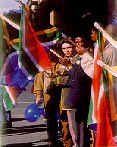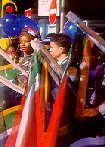
For most of the past 100 000 years, South Africa has been occupied by small, mobile groups of hunter-gatherers. They expressed their beliefs, rituals, outlook and activities in abundant rock art, and were only gradually displaced by agro-pastoralists whose presence goes back hardly more than 2000 years. The former has been described as San And the latter as Khoikhoi - two distinct cultural groups.
About 1500 years ago, immigrant Bantu-speakers began to work the soil, mainly in the river valleys of south-eastern Africa where summer rainfall predominates.
The arrival of Europeans in southern Africa proved to be a traumatic experience for the resident communities: first the Portuguese, and later the Dutch, English and French, all of whom saw the value of the Cape as a strategic outpost on the route to empires in the East.
The Dutch set up a mainland base for the East India Company (VOC) in 1652, to provide passing ships with food, water and hospitalisation for sick sailors.
The Khoikhoi realised from the building of a stone castle (the landmark Castle of Good Hope) and settlement of farmers on the land that the Dutch intended to stay, and began to resist barter and to fight off attempts by VOC expeditions to take their livestock by force.
The VOC's need for labour was so urgent that they brought in slaves from their eastern empire and from regions elsewhere in Africa, within the first decade of settlement. The Cape had become a society composed of distinct and unequal legal groups, and free blacks were never numerous or strong enough to break down the barriers.
From the early days of the settlement, slaves tried to escape, generally unsuccessfully. Europeans moved out to hunt, barter, steal and to settle with their livestock. They moved into a 'frontier' zone already peopled by San hunters, and further north and east by Bantu-speaking pastoralists. By the 1880s, the San settlements had been driven north across the Gariep (Orange) River, after a century of conflict.
There was another frontier of conflict, some 1 000 km east of Cape Town, in the area between the Sundays and the Kei rivers. Here, Khoikhoi and Bantu-speaking settlers encountered European Intruders who, like them, valued and the land as an asset.
Fom 1836 to 1838, tension on the frontier led to a second, more deliberate emigration from the Cape Colony, known as the Great Trek. Organised Voortrekker parties moved northwards in protest against British frontier policy to set up republics of their own in what was reputedly empty land.
By 1900, diamonds had been discovered near the confluence of the Orange and Vaal rivers, and then gold: first in the Tati area, then as alluvial nuggets in the eastern Transvaal and as dust embedded in rock on the Witwatersrand. Prospectors arrived, mainly from Britain. They drew in black migrant workers and shanty towns were set up. Sovereignty over the diamond fields was contested. The strongest legal claims based on occupation were those of the Griqua and Rolong, and in terms of international agreements that of the then Orange Free State (OFS). A british mediator awarded the territory to the Griqua.
In 1871, Britain accepted control of the area at the Grigua's request, as the Crown colony of Giqualand West. The OFS was conciliated by a cash settlement in 1876, but the problem of instate relations did not die down: the Phuting fought against Cape forces, and the Pedi against Boers and the British. However, the Africans also fought one another - notably the Ngqika-Mfengu conflict in the trans-Kei in 1874, and that within the Rolong and Tlhaping chiefdoms on the edge of the Kalahari. As a result, all African chiefdoms south of the Limpopo had fallen under white rule before 1900.
Meanwhile, the British Government resolved to bind the separate territories in a federal scheme, of which the annexation of the then Transvaal vaal by a coup in 1877 formed part.
This scheme was effectively quashed by a Boer victory over the British at Majuba in 1881, but the consolidation of Transvaal gold-mining threatened to upset the economic balance of the region to the disadvantage of the coastal colonies to such an extent, that Britain set about weakening that republic, now under the leadership of Paul Kruger, through encirclement.
This led to confrontation between Kruger and Cecil Rhodes, the Cape Premier. When Rhodes was discredited as a result of his plotting of a second coup against the republic in the Jameson raid of 1895, the mantle of British policy fell on Sir Alfred Milner's shoulders, and it was his pressure, supported by Joseph Chamberlain, the British Colonial Secretary, that induced Kruger to pre-empt a British declaration of war in October 1899.
Militarily, the conflict between Boer and British forces can be divided into two phases: first, a period of Boer commando successes, quickly reversed after the arrival of the main British force in January 1900, and second, a guerrilla phase when the Boer forces regrouped after the fall of Pretoria and carried on the conflict for two years before reluctantly accepting peace terms from the British in May 1902 in the Treaty of Vereeniging.
However, the Boers, having lost the war, won the peace. the victors decided to grant generous terms to the Boers, in order to ensure an enduring influence in southern Africa. This was largely at the expense of Africans, who were excluded from political power and forced to give back much of the land retaken from Boers during the war years. Britain implemented this decision from 1906 to 1907, by granting constitutions which gave Afrikaners political control of both ex-republics. However, they did not object in 1909 when the South African National Convention opted for a Constitution which ensured the retention of political power in white hands.
After the return of self-government, the dominant mood within Afrikanerdom was one of conciliation. This brought Louis Botha and Jan Smuts to the head of a coalition government, and the English-speaking Unionist Party disappeared from the political scene.
Earlier attempts to consolidate Afrikanerdom behind cultural and political movements in the 1870s and 1800s were revived, and found a focus in a reaction against the imperial connection and in position to war against the Germans in 1914. A new Afrikaner republicanism, with Gen JBM Hertzog as its interpreter, boosted by the covert Broederbond, emerged to look after the Afrikaner people.
The imperial link remained a problem, but one which Hertzog was able to resolve for his followers by accepting a face-saving formula in 1926, when he was Prime Minister. This entailed that South Africa could retain membership of the British Commonwealth on a basis of legal parity under the Crown.
When World War II broke out in 1939, Hertzog failed to keep South Africa neutral. Dr DF Malan and his 'purified' nationalists, who had broken away from Hertzog in 1934, built up a strident opposition during the war years, yet managed to keep within the discipline of parliamentary government.
In 1948, Malan's National Party (NP) gained a majority of seats on a minority of votes. Under successive leaders, notably Hendrik Verwoerd, John Vorster and PW Botha, it held power until 1994. To get rid of coloured voters, it overrode the Constitution. In 1961 it worked its way out of the Commonwealth without incurring the wrath of English-speaking voters.
After 1948, the NP bonded itself to the apartheid ideology. The plan was to fabricate a permanent, white political majority by purging the voter's role of all blacks, and by creating 'homelands' for all Africans where political provision could be made for them leading up to self-government.
This move included enforcement of total segregation. Apartheid also included the retention of economic power in white hands, by directing skilled blacks into their own areas.
For a time this was linked to a policy of industrial decentralisation, so that centres on industry could be set up on the borders of homelands, to which black and white employees could travel from opposite sides without infringing delimitation's of group areas.

 South Africans rejoice as they gather to wish their new country
a happy first birthday on Freedom Day, 27 April 1995 (photograph: Stuart
Semple, SACS).
South Africans rejoice as they gather to wish their new country
a happy first birthday on Freedom Day, 27 April 1995 (photograph: Stuart
Semple, SACS).
Extra-parliamentary politics in South Africa began to take shape in the colonies and republics well before the end of the 1800s. The body which emerged in 1912 as the South African Native, later the African National Congress (ANC), looked back for its origins to a group of provincial 'native congresses' and a South African Native Convention whose protests against the decisions of the white National Convention in 1909 had gone largely unnoticed.
Resistance grew perceptibly during World War II, and reached a climax with a mineworkers' strike and a walk-out by Hertzog's abortive Native Representative Council in 1946.
A decade of direct confrontation during the 1950s followed, when the main body of apartheid legislation was enacted and black movements threw all they had into defiance. Then came Sharpeville. Police killed 69 and wounded 180 African pass protesters in this Transvaal township.
The ANC went underground, with a strategy of controlled but accelerating violence. A breakaway Pan Africanist Congress (PAC) was less accommodating, and its offshoot Poqo began a campaign of terror. With bases in exile, both the ANC and the PAC struggled for over a decade without managing to penetrate the security of the apartheid state - despite growing international support.
By the 1970s the balance began to change. The oil-price hike of 1973 led to worldwide inflation, and put such pressure on living costs that black south African workers broke the ban on strike activity and were able to obtain important wage gains from employers. In 1976, a revolt by students in Soweto against the substandard educational system spread like wildlife throughout the country, on the heels of a new black consciousness movement set up under Steve Biko's guidance to encourage Africans to walk tall. The arrest and killing of Biko in police custody created a fresh outburst of public anger.
States of emergency, first brought in after Sharpeville and repeated in 1976 and 1985, proved less and less effective. The liberation of Africa had reached South Africa's borders with the end of the Rhodesian war and the collapse of colonial Mozambique. International trade and armaments boycotts escalated with the involvement of South African troops in war on the Angolan border - a major economic and military challenge.
The intensity of conflict in Africa dropped with the collapse of the Soviet Union, making the American policy of 'constructive engagement' realistic. The ANC had built up a position of strength far greater in the outside world than within South Africa, or that of South Africa in the outside world. However, it was closely linked to the Mass Democratic Movement, an internal response to President PW Botha's attempt to set up a new parliamentary system in 1983 which included coloured and Indian representatives but no Africans.
The ANC's role in any movement forward was shown in the decision of white leaders to engage its exiled leaders in exploratory conversations during 1988 and 1989. The upshot was a decision by President FW de Klerk to release the imprisoned ANC leader, Nelson Mandela, unconditionally in February 1990.
At this point the ANC's consistent adherence to the principle of non-racial democracy paid enormous dividends. it created a group base of trust which enabled all political parties to meet at the World Trade Center near Johannesburg from 1991 to 1993 and to hammer out a transitional Constitution.
Conciliation won through both the constitutional negotiations and the first democratic election, held in April 1994, despite serious attempts to undermine them. This led to a Government of National Unity. Its greatest challenges, the drafting of a final Constitution, and the major task of socio-economic reconstruction and development still lie ahead.

 go back
go back